




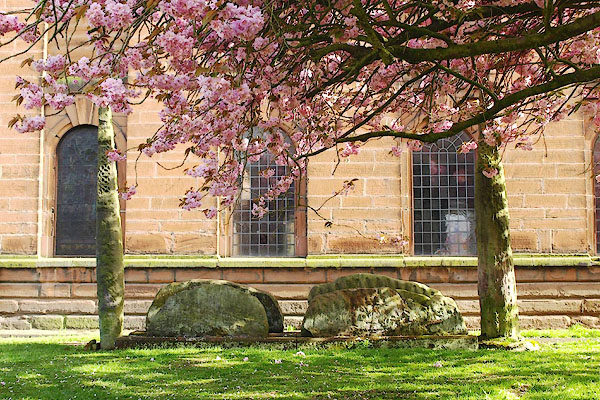
BQL92.jpg (taken 1.5.2009)
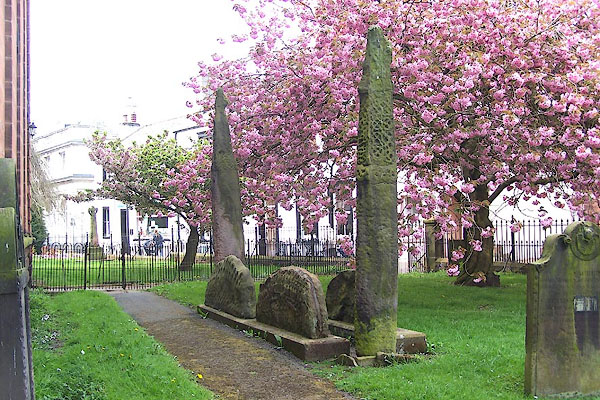
BMC55.jpg (taken 12.5.2006)
placename:- Giant's Grave
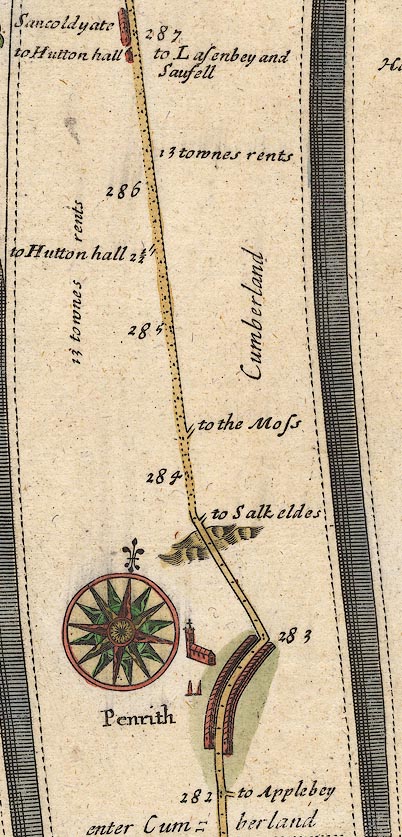
OG38m282.jpg
In mile 282, Cumberland.
Two pillars near the church in Penrith.
item:- JandMN : 21
Image © see bottom of page
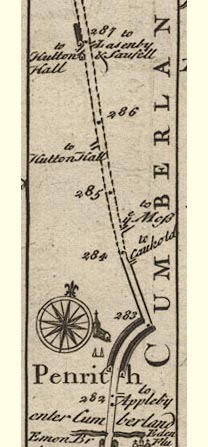
B094m282.jpg
Notice the two vertical ?stones drawn by the church at Penrith. "... In ye Church Yard on ye North Side of ye Church, are 2 large Pillars, about 4 Yards high, and 5 Yards distant, which as ye Tradition goes, were erected in Memory of one Sr. Owen Casarins Kt. a famous Warriour of Old, of great Strength & Stature, who Lived in these parts & Killed wild Bears &c. He was Buryed here & (as tis related) was of that vast extent as to reach from one Pillar to ye other. Tis further Added that ye Rude Figures of Bears wrought in Stone &placed on each side his Grave, are in Memory of his great exploits. ..."
item:- Dove Cottage : 2007.38.100
Image © see bottom of page
placename:-
"At Penrith also we saw several remarkable things, some of which I find mentioned by the right reverend continuator of Mr. Cambden, and which I was glad to see, so confirm'd my observation, viz. ... Two remarkable pillars fourteen or fifteen foot assunder, and twelve foot high the lowest of them, though they seem equal. The people told us, they were the monuments of Sir Owen Caesar, the author above nam'd calls him, Sir Ewen Caesarius, and perhaps he may be right; but we have no inscription upon them. This Sir Owen, they tell us, was a champion of mighty strength, and of gygantick stature, and so he was, to be sure, if, as they say, he was as tall as one of the columns, and could touch both pillars with his hand at the same time."
"They relate nothing but good of him, and that he exerted his mighty strength to kill robbers, such as infested the borders much in those days, others related wild boars; but the former is most probable."
item:- wild boar; boar; Inglewood Forest
 goto source
goto source"..."
"In the Church Yard of this Place, on the N. Side of the Church are two large pyramidal Pillars, erected about four Yards high each of them, and about five Yards distant from one another: These, it is said, were set up in Memory of one Sir Owen Caesar, Knight, in old Time, a famous Warrior of great Strength and Stature, who lived in these Parts, and kill'd wild Boars in the Parish of Englewood, which much infested the Country: He was bury'd here, and, as Tradition reports, was of that prodigious Stature, as to reach from one Pillar to the other; to which it farther adds, That the rude Figures of Boars, which are wrought in the Stone, and placed on each Side of his Grave, are in"
 goto source
goto source"Memory of his great Exploits on those Creatures."
 goto source
goto sourcePage 170:- "In the church-yard are some sepulchral monuments, which have long been the subject of antiquarian speculation, not yet decided. Thus much is evident, that the pillars alluded to are of one stone, formed like the ancient spears; the shafts round, for about seven feet high; above that, they appear to be square, and to have terminated in a point. They are about ten feet high, stand parallel to the church, distant from each other fifteen feet. The space between is inclosed with circular stones, by some conjectured to represent boars. There remains visible, on the upper part of the pillars, some ornamental work, but no inscription or figures appear at present, and the stones are so much fretted by time, that it rests upon mere conjecture to affirm there ever were any. They probably mark the tomb of some great man, or family, before the custom was introduced of interring within churches, and are most likely British, or if not, must be Saxon."
placename:- Giant's Grave
 goto source
goto sourcepage 16:- "..."
"In the church-yard is a curious monument of antiquity, generally called the Giant's-Grave: it consists of two pillars, about four yards high, and 40 inches in circumference, placed parallel to the side of the church, and distant about five yards from each other: on these is the remains of carved work, and from one to the other are two rows of large stones cut into segments of circles, likewise bearing marks of sculpture, and inclosing a small area. The origin of this, like most of our northern antiquities, is obscure, some affirming it to be the burying-place of one champion, some of another: most of them however agree, that his sirname was Caesarius, though one calls him Sir Owen, another Sir Hugh, and a third Sir Ewan."
"Dr Burn tells us, upon the authority of Mr Sandford's manuscript history, that Sir Hugh Caesario had an hermitage in that neighbourhood called Sir Hugh's Parlour: ..."
 goto source
goto sourcePage 17:- "... Mr Sandford farther says, whilst he was Schoolmaster in Penrith, this place was opened by William Turner, and the bones of a man of extraordinary stature, and a broad sword, were found there."
"An equally probable account of this place is taken from an old tradition and song, which informs us that one Torquin, a man of gigantic stature, but addicted to all kinds of rapine and brutality, lived in a cave in this neighbourhood, on the banks of the river Emont. This den, which yet retains the name of the Giant's Cave, is about two miles from Penrith, ..."
 goto source
goto sourceGentleman's Magazine 1788 pp.803-804 "... 'Antiquarians have not been able to decypher the inscription on the"
page 804 "'stone in Penrith church-yard.' This is the first time we ever heard there was an inscription on it; and we dare not set our anonymous traveller's opinion against the respectable names that have gone this way before him."
placename:- Giant's Grave
item:- robbers; wild boar
 goto source
goto sourcePage 188:- "..."
"... On the north side [of the church] in the church-yard are two square obelisks, of a single stone each, 11 or 12 feet high, about 12 inches diameter, and 12 by 8 at the sides, the highest about 18 inches diameter, with something like a transverse piece to each, and mortified into a round base. They are 14 feet asunder, and between them is a grave inclosed between four semicircular stones of unequal lengths of five, six, and four and an half, and two feet high, having on the outsides rude carving and the tops"
 goto source
goto sourcePage 189:- "notched. This is called the Giant's Grave, and ascribed to sir Ewan Caesarius, who is said to have been as tall as one of the columns, and capable of stretching his arms from one to the other to have destroyed robbers and wild boars in Englewood forest, and to have had an hermitage hereabouts called sir Hugh's parlour. From the latter part of this tradition Dr. Todd describes the four stones as cut in the form of boars, which, unless he saw them less sunk in the ground than at present, can only mean that they were cut round, and perhaps rough on the edge like the back of those animals. The Doctor supposes these pillars were intended to place corpses on at the north or Death's door of the church; but their height contradicts this, and the name of Grave, given to it by uniform tradition, assigns it as the burying-place of some considerable person, whose eminence is expressed by the distance of the stones asunder. Mr. Sandford says the place was opened in his time, and the great long hand-bones of a man, and a broad sword were found. ..."
item:- Battle of Torquin and Sir Lancelot; Reliques of Antient English Poetry; Arthurian legend
 goto source
goto sourceGentleman's Magazine 1791 p.991 "..."
"Two circular stone pillars, resembling ancient spears, near 12 feet high, and 14 assunder, point out to us The Giant's Grave, in Penrith churchyard; but the particulars of this curious monument of antiquity have been so frequently given, that to add here would be superfluous. Tradition, mostly something to rest upon, informs us that Torquin, refusing to obey the summons of King Arthur to appear at his Court, to answer for the ravages he daily committed, Sir Lancelot du Lac was dispatched to bring him by force. A battle was the consequence; Torquin fell, and was buried betwixt these pillars. The battle, I think, is celebrated in many ballads of the antient poets. The following, which I thought curious, may be met with in Percy's "Reliques of Antient English Poetry.""
"When Arthur first in court began, and was approved King,
By force of arms great vict'ries wanne, and conquest home did bring,
Then into England straight he came with fifty good and able
Knights that reverted unto him, and sate at the Round Table*."
"And he had justes and tournaments, whereto were many prest,
Wherein some knights them did excelle, and far surmount the rest;
But good Sir Lancelo du Lake, who was approved well.
He for his deeds and feats of armes all others did excell."
"When he had rested him awhile in play, and game, and sporte,
He said he would go prove himself in some advent'rous sorte.
He armed rode in forrest wyde, and met a damsell faire,
Who told him of adventures great, whereto he gave good eare,"
""Such wold I find," quoth Lancelot, "for that came I hither."
"Thou seem'st," quoth she, "a knight full good, and I will bring thee thither,
Whereas a mightye knight doth dwell, that now is of great fame;
THerefore tell me what wight thou art, and what may be thy name.""
""My name is Lancelot du Lake." Quoth she, "It likes me than,
Here dwells a knight who never was yet match'd with any man,
Who has in prison threescore knights and four that he did wound;
Knights of King Arthurs courts they be, and of his Table round.""
"She brought him to a river side, and also to a tree,
Whereon a copper bason hung, and many a shield to see.
He struck so hard the bason broke, and Torquin soon he spy'd,
Who drove a horse before him fast, whereon a knight was ty'd."
""Sir Knight," then said Sir Lancelot, "bring me that horse-load hither,
And lay him downe, and let him rest, we'll try our force together;
For, as I understand, thou hast, as far as thou art able,
Done great despite and shame unto the Knights of the Round Table.""
"*At Eamont bridge, not more than a mile and a half from Penrith, is a circus, 40 yards in diameter, with a deep ditch, having an entrance on the North and South; it is called "King Arthur's Round Table." This, with the very fine Druidical temple at Mayborough, close by, have frequently been noticed by antiquaries."
 goto source
goto sourceGentleman's Magazine 1791 p.992 ""If thou be of the Table Round," quoth Torquin speedily,
"Both thee and all thy fellowship, I utterly defy."
"That's over much," quoth Lancelot, "defend thee by-and-by."
They set their spurs unto their steeds, and at each other fly."
"They coucht their spears (their horses ran as tho' there had been thunder)
And strucke each other amidst their shield, wherewith they brake in sunder;
Their horses backs brake under them, the knights were both astound;
T'void their horses they mad haste, and light upon the ground."
"They took them to their shields full fast, their swords they drew out than,
With mighty strokes most eagerlye each at the other ran;
They wounded were, and bled full sore, for breath they both did stand,
And leaning on their swords awhile, quoth Torquin, "hold thy hand,"
""And tell to me what I do ask." "Say on," quoth Lancelot. "Tho'
Thou art," quoth Torquin, "the best knight that ever I did know,
And like a knight that I do hate, so that thou be not hee,
I will deliver all the rest, and eke accord with thee.""
""That is well said," quoth Lancelot, "but sith it must be so,
What knight is that thou hatest thus, I pray thee to me show."
"His name is Lancelot du Lake, he slew my brother deare;
Him I suspect of all the rest; I would I had him here.""
""Thy wish thou hast, but yet unknown, I am Lancelot du Lake,
Now knight of Arthur's Table Round; - 's son of Southake;
And I defy thee, do thy worst." "Ho! ho!" quoth Torquin, "Ho!
One of us two must end our lives before that we do go.""
"They buckled them together so, like unto wild boars rushing,
And with their swords they ran at one another flashing;
The ground besprinkled was with blood. Torquin began to yield,
For he gave back for weariness, and low did bear his shield."
"This soon Sir Lancelot espy'd. he lept upon him then,
He pull'd him down upon his knee, and swashed off his helm;
Forthwith he struck his neck in twain, and when he had so done,
From prisone threescore knights and four delivered every one."
"Yours, &c."
"W.M."
placename:- Giant's Grave
 goto source
goto source"[Penrith] ... In the church-yard are two ancient rude stone obelisks, set up at each end of what is called the Giant's Grave, and said to have been erected to the memory of Sir Owen Caesarius, a famous warrior, who destroyed the robbers and wild beasts that infested Inglewood forest; and the credulous believe that his body reached from one pillar to the other, being nearly 5 yards. ..."
placename:- Giant's Grave
 goto source
goto sourcePage 131:- "[Penrith] ... In the churchyard is a curious relic of antiquity, called the Giant's Grave, consisting of two large pillars, ten feet in height, and distant fifteen feet from each other in the direction of east and west, having the space between them partly enclosed on each side by four large thin stones. ..."
 goto source
goto sourcePage 170:- "... In the churchyard of Penrith is the monument about which nobody really knows any thing, though it goes by the name of the Giant's Grave. It consists of two stone pillars, with four slabs between them, set up on edge. There are some undecipherable carvings on the upper part of the pillars. This was the monument which Sir. Walter Scott's"
 goto source
goto sourcePage 171:- "family could not get him past, (though they had all seen it "dozens of times,") when, failing and infirm, he set out on his last sad journey, in pursuit of health. Passing through Penrith, he would see the Giant's Grave; and thither he limped, to wonder once more what it could mean."
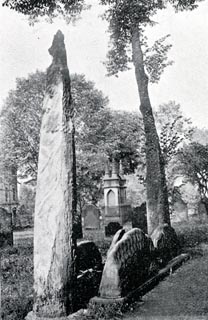 click to enlarge
click to enlargeUN106.jpg
item:- JandMN : 1023.6
Image © see bottom of page
placename:- Giant's Grave
item:- wild boar; vandalism
Page 133:- "..."
"... the chief interest - and mystery - of the spot [St Andrew's Church] is the so-called "Giant's Grave," in the churchyard. No one knows who rests here, but for choice it is the grave of a chief among those Scandinavian settlers who established themselves in these northern counties in the tenth century. Legend, of course, steps in to explain that of which archaeology is ignorant. The invincible hardihood of legends is such as to command the astonished respect of the calmest mind; and here we are bidden by old folk-lore to look upon the grave of one Sir Hugh Caesarius, a man of colossal proportions, but as big-hearted, metaphorically, as he was high, who cleared the surrounding Inglewood Forest of the wild boars that were a terror to the people, at some period not specified. The tall grey sandstone pillars that stand over his grave, at a distance apart of fifteen feet, are supposed to mark his height, and are covered with Runic devices, greatly defaced and pitifully weather-worn. Rude hunch-backed stones between them are popularly supposed to represent the backs of boars."
HP01p134.txt
Page 134:- "These hoary relics had a narrow escape of being totally destroyed by those who pulled down the old church; and the work of breaking them into pieces had already begun when the indignant people of the town stopped it. The clamps marking"
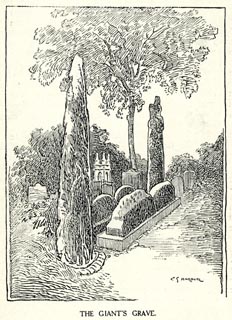 click to enlarge
click to enlargeHP0119.jpg
"THE GIANT'S GRAVE."
"where the broken pillars were mended are clearly to be seen. A stone, really the head of an ancient cross, near by, is said to mark the place where the giant's thumb is buried."
item:- JandMN : 1055.20
Image © see bottom of page
placename:-
"... The churchyard contains two ancient sandstone pillars with traces of Runic decoration, set at either end of what is known as the Giant's Grave. ..."
placename:- Giant's Graves
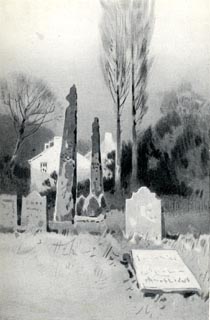 click to enlarge
click to enlargeRSN105.jpg
Tipped in opposite p.16 of Wordsworthshire by Eric Robertson.
Showing the Giant's Grave and the Hutchinson Family tomb.
printed at bottom:- "PENRITH CHURCHYARD / ('Giant's Graves' and, in nearest foreground, Hutchinson family tomb)"
item:- JandMN : 197.5
Image © see bottom of page
placename:- Giant's Grave
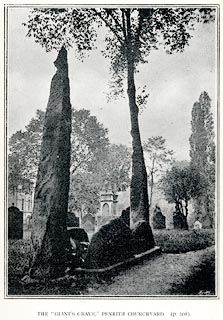 click to enlarge
click to enlargePS1E72.jpg
On p.207 of Pearson's Gossipy Guide to the English Lakes and Neighbouring Districts.
printed at bottom:- "THE 'GIANT'S GRAVE,' PENRITH CHURCHYARD. (p.208)."
item:- Armitt Library : A1188.79
Image © see bottom of page
item:- hogback gravestone; cross
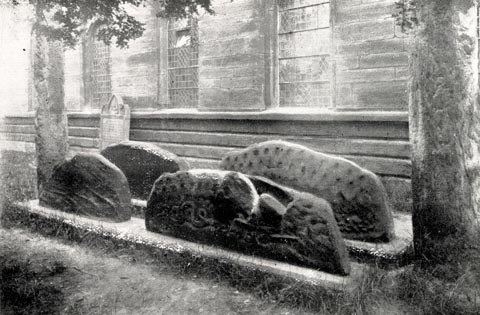 click to enlarge
click to enlargeCV1131.jpg
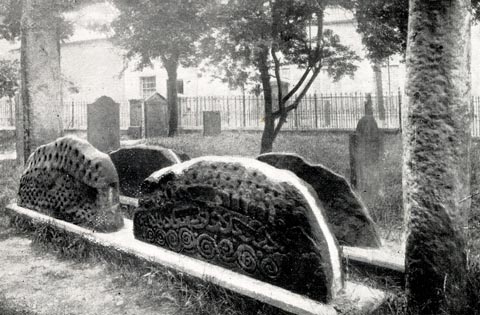 click to enlarge
click to enlargeCV1132.jpg
item:- JandMN : 190
Image © see bottom of page
placename:- Giant's Grave
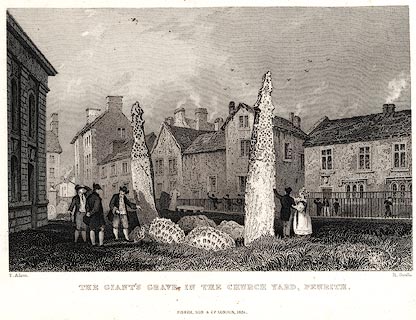 click to enlarge
click to enlargePR0033.jpg
vol.3 pl.4 in the set of prints, Westmorland, Cumberland, Durham and Northumberland Illustrated.
printed at bottom left, right, centre:- "T. Allom. / R. Sands. / THE GIANT'S GRAVE, IN THE CHURCHYARD, PENRITH. / FISHER, SON &CO. LONDON, 1835."
item:- Dove Cottage : 2008.107.33
Image © see bottom of page
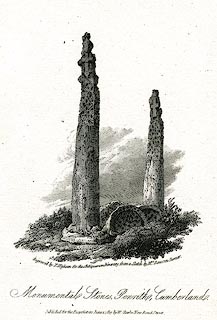 click to enlarge
click to enlargePR0108.jpg
Included in the Antiquarian Itinerary.
printed at bottom:- "Engraved by T. Higham for the Antiquarian Itinerary from a Sketch by Mrs. Dawson Turner. / Monumental Stones, Penrith, Cumberland. / Published for the proprietors June 1. 1817. by W. Clarke. New Bond Street."
item:- Dove Cottage : 2008.107.108
Image © see bottom of page
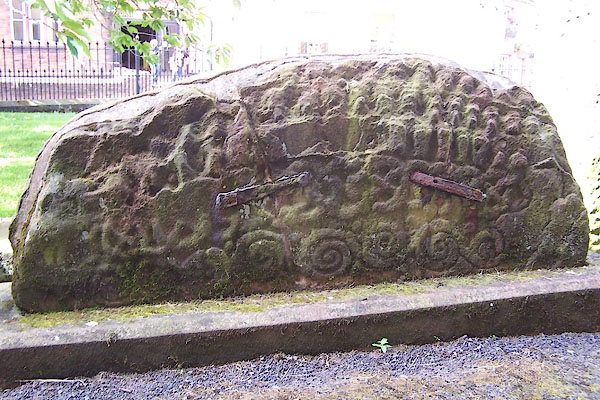
BJQ57.jpg (taken 22.7.2005)
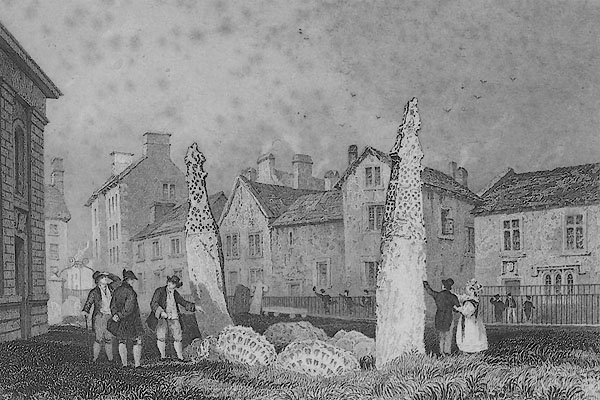
BMC56.jpg Drawn by T Allom, engraved by R Sands, published by Fisher ans Co, 1820s.

BMC57.jpg 19th century engraving of the hogback gravestones.
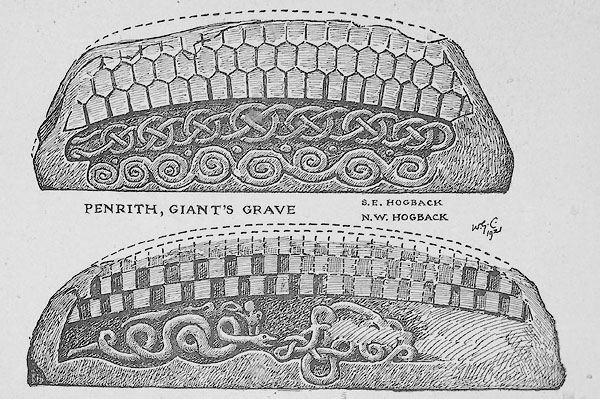
BMC58.jpg 19th century engraving of the hogback gravestones.
